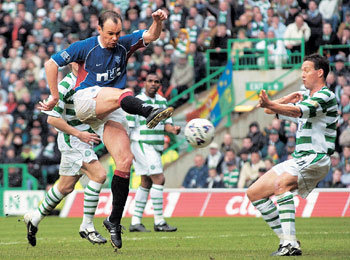Soccer: A Battlefield of Brutality and Desire
Soccer: A Battlefield of Brutality and Desire
Posted March. 18, 2005 22:39,

Why is it that a national soccer game between Korea and Japan is not regarded as a regular game of sports? With relations between the two countries at a boiling point these days due to Japans reckless remarks regarding the sovereignty of Dokdo islets, is it possible for the fans of the two teams to peacefully gather together in one stadium?
To answer this question, we must first understand the cultural, ethnic, and historical relations between Korea and Japan. Likewise, this book has dealt with race and cultural ideology that lie behind soccer. Although the relations between Korea and Japan were not mentioned, the author exposed the racial conflicts between Serbia and Croatia, the dispute between Scotlands Catholics and Protestants, Spains Cataluna nationalism and Italys coalescence between sports and politics, and more, through soccer.
To the author, soccer is not a mere sport, but a battlefield in which a human beings innermost desires and barbarism writhes. The merit of soccer is the fiery glare and ferocious tackles, the scuffles with splattering sweat and blood, but the book tells us that these aspects may be the horrifying core of a human being.
The hooligans (maniacal soccer fans) of the Red Star Beograd club in Serbia are violent to the point of beating unfavorable players with clubs. Also called the Ultra Bad Boys, they are the storm troops of Slobodan Milosevic, a former Yugoslavian president, who ignited the extremist Serbia nationalism and operated as a commissioner of ethnic wipeout. On days when Serbia and Croatia teams play, fans of both teams holler out cheers singing the justification of the slaughters they have committed.
The fans of the Catholic Celtic and the Glasgow Rangers clubs based in Glasgow, Great Britain, cry out songs of hatred directed at each other at the stadium. The conflict of both sides is superimposed with the long-lived disputes between Catholics and Protestants, the Irish and the Scottish. The cheers lyrics that even sing, The blood of wet our knees, are gruesome, and several have been murdered because of soccer in this city.
In Italy, the soccer field itself is an open war. Here, the soccer referee is a star. The reason referees receive V.I.P. treatment is because players embellish the game with interruptive and violent protests or schemes.
AC Milan and the Juventus, who control Italian soccer, possess conglomerates. The team owner of AC Milan, Prime Minister Silvio Berlusconi, used soccer as a way to approach the citizens after seizing real estate, media, and finance circles. In the mid 1980s he bought AC Milan and as the team flourished, he consolidated supporters by saying, We will make Italy like AC Milan.
Spains FC Barcelona team represents Cataluna nationalism. Due to this fact, under Franco, they were persecuted. However, like the Basque separatists, the fans of this team do not reveal their rage outside the playing field. The author analyzes this as the unique pragmatic attributes of Cataluna.
The writer is a soccer fan and a reporter at a conservative newsweekly called New Republic. Although the writer has exposed soccer with specific case examples and interviews that display a journalists style, there is one more thing he wants to say, and that is a question that he asks, If an internationalized sport like soccer cannot be free from a proxy war of conflicts, than can it be that globalization is a lie? The original title of the book is How Soccer Explains the World, and was published in 2004.
Yeub Heo heo@donga.com







